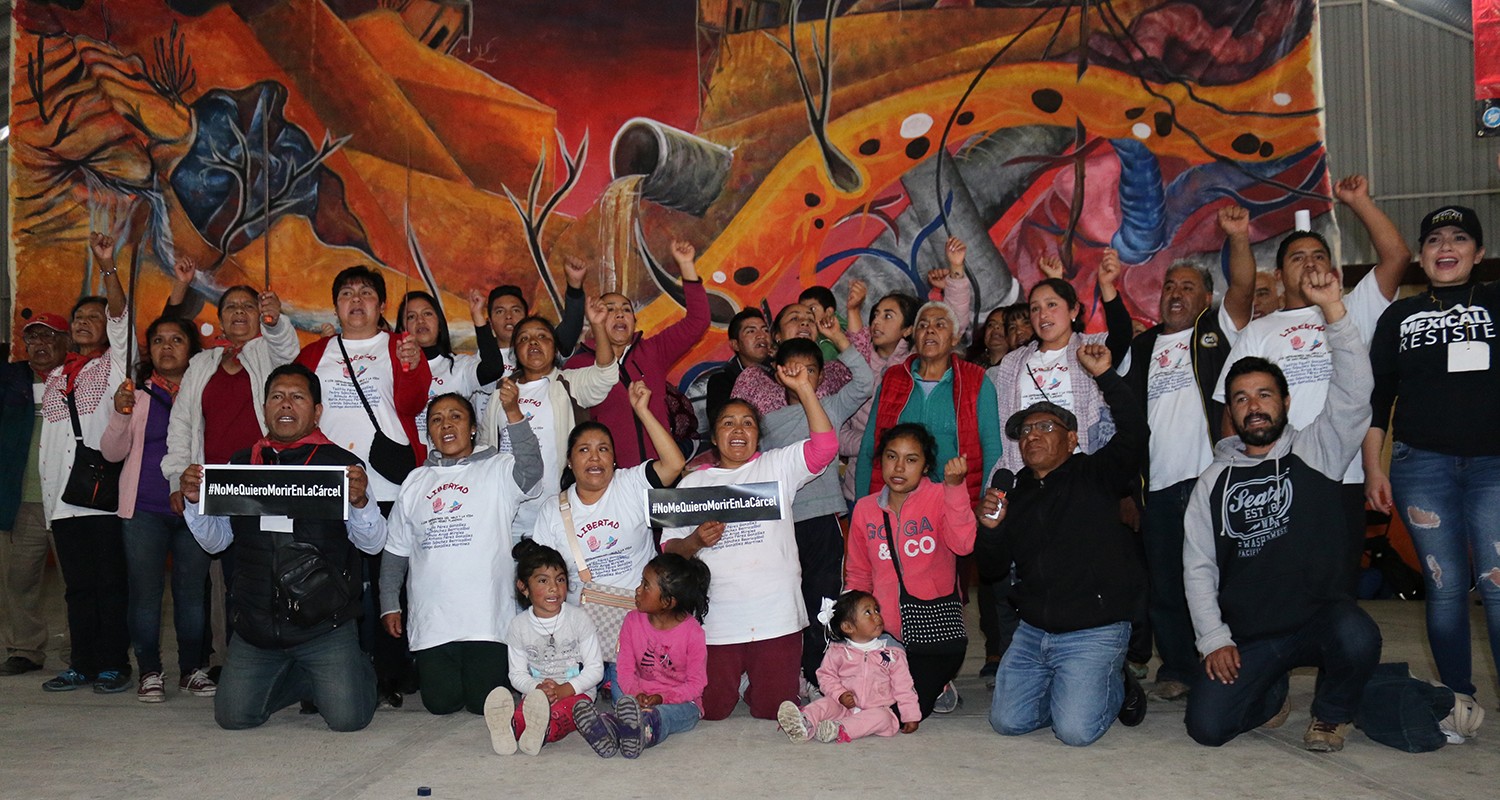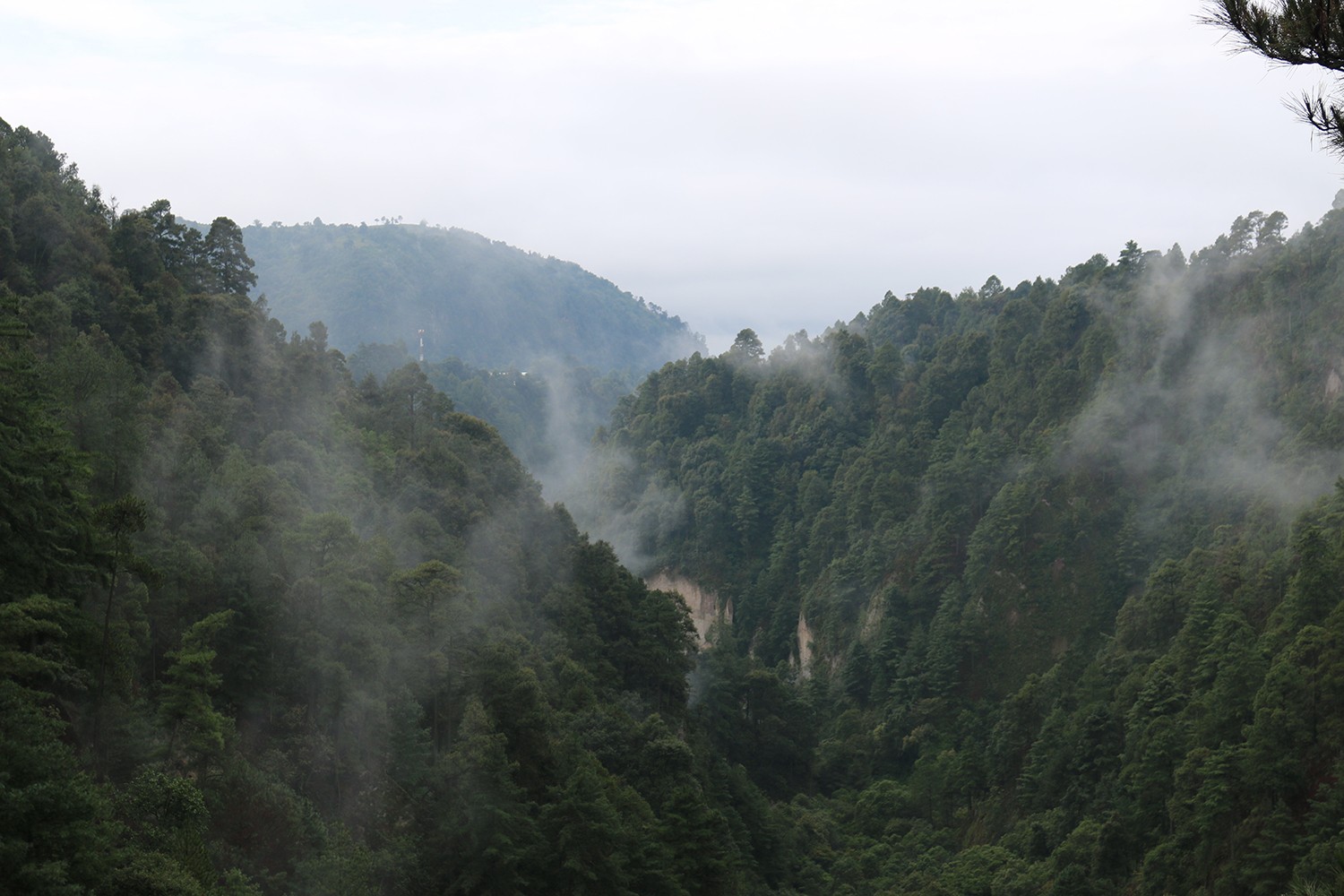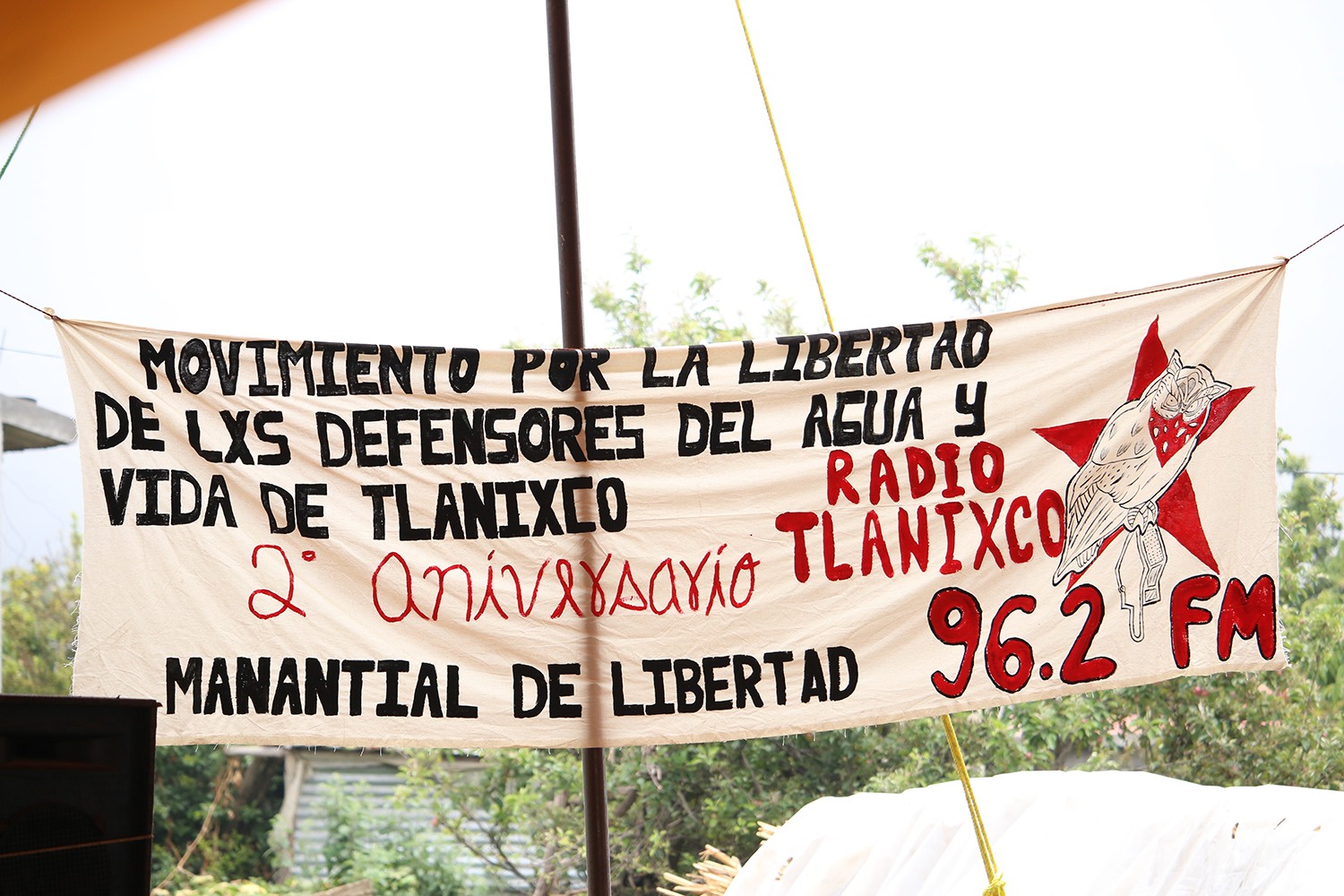Filed under: Editorials, Indigenous, Land, Mexico, Political Prisoners, Revuelta Comunitaria

The following column looks at the struggle of the indigenous community of San Pedro Tlanixco in the State of Mexico to defend its water and territory and gain freedom for its political prisoners. It also recaps the Gathering in Defense of Water, Territory, and Life, recently held in Tlanixco, that brought together communities and organizations in resistance from around the State of Mexico.
From high on the ridge at the edge of the Indigenous Nahua community of San Pedro Tlanixco, through the fog that daily rolls up and down the mountain, you can see in the distance the many greenhouses that line the rim of the canyon. The greenhouses belong to the neighboring municipality of Villa Guerrero, which sits further down the mountain from San Pedro Tlanixco, but alongside the same Arroyo Grande, or Texcaltenco River. The greenhouses are filled with roses, lilies, gerberas and other flowers, cultivated specifically for international export. The flower interests working in Villa Guerrero are transnational.
The community of San Pedro Tlanixco is located on the slopes of the Nevada de Toluca Volcano, in the State of Mexico. Due to its location, the community benefits from plentiful water that the mountain and forest attract and produce. However, in the 1980s, transnational flower interests installed themselves in Villa Guerrero, the municipality below the community of San Pedro Tlanixco, to take advantage of the favorable climate and most importantly the water to grow their flowers. Between the interests of the community of San Pedro Tlanixco, and that of the transnational flower vendors, the fresh-water springs that lead into the river have become the object of serious dispute. In defending their territory and resources against these transnational flower interests, the community of San Pedro Tlanixco has faced serious state repression including persecution and long-term imprisonment. In this way, the struggle for water in San Pedro Tlanixco exemplifies another case of community struggle against the state-backed war of capitalism on Indigenous territories.
With the arrival of transnational flower interests in the late 1980s in Villa Guerrero, and their interest in better controlling the water in Arroyo Grande, the Indigenous Nahua community of San Pedro Tlanixco began to organize resistance. They had previously been engaged in another struggle against territorial dispossession, which they lost, ending in the construction of a highway extension project, Tenango del Valle-Ixtapan de la Sal, literally splitting the community into two. The Tenango del Valle-Ixtapan de la Sal highway project was part of a larger highway system project, Toluca-Tres Marías. The expropriation of land for the construction of the highway was marked by its illegality, as any expropriation of ejido lands requires an agreement with the ejido assembly—an agreement that in this case didn’t exist. With the arrival of the transnational flower interests, the already organized and politically conscious community began to engage in the defense of their water.

San Pedro Tlanixco
As the struggle in defense of water in San Pedro Tlanixco heated up, the community engaged in a diversity of tactics to defend their territorial resources, from legal appeals to road blockades. In 2000, the community won a legal battle ending with the National Water Commission authorizing the community’s concession to four fresh-water springs: Bellotal, Puente de Trozo, Agua Bendita, and Salitre. However, shortly after in 2001, the National Water Commission began the paperwork to nullify the water concessions previously granted to the community. In a community assembly in August of 2001, the community decided to blockade the Tenango del Valle-Ixtapan de la Sal highway on the day the National Water Commission, the Water Commission of the State of Mexico, and the Sub-Secretary of Government were to hold a meeting in the community to resolve the legal situation surrounding the rights to the water. With the pressure from the road blockade, a dialogue was implemented, ending in the community maintaining its right to the water. In addition to that legal victory, perhaps most importantly, the action strengthened the spirit of rebellion and community organization in defense of water and territory.
In 2001, after thirteen years of struggle, the community of San Pedro Tlanixco joined forces with the National Indigenous Congress. “We saw that we share the values of struggle, the pain and rage of others that are also part of the CNI” (1). After their participation in a regional meeting of the National Indigenous Congress in January of 2003, their struggle became clearer: “…from that meeting we began to understand that only organizing ourselves and spreading our word with other peoples and struggles, was how we could make visible what was happening to us. We also took note that we were not alone and that our struggle is also the struggle of our compañeros and compañeras of the CNI” (2).
In April of 2003, Alejandro Isaac Basso, a Spanish businessman and president of the Association of Irrigation Water of Rio Texcaltengo, accompanied by various others from Villa Guerrero, followed the river upstream into the territory of San Pedro Tlanixco. Their mission was to check why the water running downstream was supposedly dirty. Community members of San Pedro Tlanixco, after hearing of their presence in the ejidal territory, went to the canyon to question them about their presence in the ejido. “In a confusing episode, Isaac Basso fell from a cliff and died. Those of Tlanixco argue that he stumbled and fell. Those of Villa Guerrero say that he was pushed” (3).
The death of the Spanish flower businessman sparked a wave of intense state repression in the community of San Pedro Tlanixco. Those active in the struggle in defense of territory and water in San Pedro Tlanixco, specifically members of the Committee of Drinking Water and Ejidal Commission, were direct targets of this state repression. “These community representatives and human rights defenders were only the most visible in defense of water and were unjustly accused, without direct evidence, of the death of one of the representatives of Villa Guerrero” (4). Arrests quickly followed.
Between 2003 and 2007, Pedro Sánchez Berriozábal, Teófilo Pérez González, Rómula Arias Mireles, Lorenzo Sánchez Berriozábal, Marco Antonio Pérez González, and Dominga González Martínez all were detained and charged with homicide and unlawful deprivation of liberty. After years of legal irregularities and judicial delays, with various compañeros spending more than ten years in jail before sentencing, all six compañeros have been sentenced to between 50 and 52 years in prison. While all the convictions are based on trumped-up charges and phony evidence, the case of Dominga González Martínez perhaps best represents the nature of the case. She was convicted based solely in that her physical characteristics matched the witness’ testimony of a “short and brown” woman, a clear example of the colonial judicial system employing racism as evidence to repress Indigenous resistance.
The state repression—arrests, intimidation, persecution—was effective, leaving members of the community of San Pedro Tlanixco afraid to organize out of fear of further arrests. This includes two members of the community who to this day remain with arrest warrants, unable to return to their community and be with their families. However, as time passed, members of the community began to regather their courage. They began to leave the community, sharing their stories of repression and resistance with other communities facing similar aggression. Little by little, they began to reweave their previously articulated community organization.
In recuperating their organizational capacity and strength, the community of San Pedro Tlanixco has fortified their involvement in the National Indigenous Congress. On May 1, 2016, the community founded Radio Tlanixco: Spring of Freedom, to facilitate community organization and political struggle. In recent months, the community has taken direct action, constructing infrastructure to move water from the river canyon up to the community for domestic use. The Committee of Drinking Water, the Ejidal Commission, and other community authorities are working together in a collective manner in defense of land and water. More and more, the community is regaining its strength, and moving forward for the freedom of their political prisoners, and in defense of their territory and autonomy as an Indigenous community.

Gathering in Defense of Water, Territory, and Life
On August 18 and 19, as part of the ongoing organization against territorial dispossession and state repression in the State of Mexico and the country more broadly, various organizations and communities in resistance met in a gathering in defense of water, territory, and life in the community of San Pedro Tlanixco. Present at the event were members of various community and regional struggles: the Frente Popular en Defensa de la Tierra and Pueblos Unidos Contra el Nuevo Aeropuerto, both struggling against the New International Airport of Mexico City; Mexicali Resiste, an organization working around various issues most pointedly against the construction of a brewery by the transnational Fortune 500, Constellation Brands, and their intention to use local water to make beer; Vecinos Unidos Zona Poniente, a neighborhood organization in the west of Mexico City struggling against the Interurban Train Mexico-Toluca; San Francisco Xochicuautla, a community in struggle against the highway megaproject Naucalpan-Toluca; among others struggles. While the specifics of the various struggles differed, common threads were shared amongst them: resistance to capitalist megaprojects, territorial defense, water defense, struggle for community self-determination, and solidarity and organization against state repression.
During the first day of the event, working groups were organized around two specific questions: What is the current political situation in Mexico and what political actions can be taken to strengthen resistance struggles in the face of this political situation? The recent election of Andrés Manuel López Obrador was at the center of much of the discussion. How do resistance struggles respond to the election of a so-called progressive government? How might resistance require a new set of strategies in the face of such an administration? While opinions differed in certain respects, the materiality of repression and dispossession being experienced in these communities animated the overall consensus: the only way to move forward was with heightened organization.
A second round of working groups was organized in the afternoon on the first day meant to address three specific themes: territorial defense, water defense and the struggle to free political prisoners. The discussion around political prisoners was particularly important, with family members and comrades from various communities sharing experiences of the emotional and physical toll of state repression and strategies for supporting long-term political prisoners. Women led this discussion, exemplifying how prison solidarity work in Mexico and more broadly is often led by women. Testimonies of state repression and prison solidarity were shared by community members from Atenco, Xochicuautla, Mexicali, Salazar, and San Pedro Tlanixco, among others.
The second day of the event was again organized around three specific themes: a workshop on free media and digital security, a working group on the struggle against the New International Airport of Mexico City, and a working group on the struggle in defense of water and against state repression in San Pedro Tlanixco. At the end of the event, a series of agreements were announced including plans for a second gathering in defense of water, territory and life to be held in Atenco in October. Perhaps most importantly though, throughout the event skills were shared and the groundwork was laid from which deeper relationships of solidarity, mutual aid, and collective action will inevitably develop.
An important aspect to the overall dynamic of the gathering was the overwhelming presence of community members, domestic workers, campesinos, construction workers, community authorities, etc. who were active in the discussions and working groups. This was not a gathering of professional activists, but of ordinary people who have direct stake in the struggle with family members in prison, lands being dispossessed, and natural resources being plundered.
The weaving together of various resistance struggles in defense of water, territory, and life at this particular event follow up on other articulations of struggle and solidarity taking shape in the State of Mexico and the country. The Frente de Pueblos en Defensa de la Tierra, Pueblos Unidos Contra el Nuevo Aeropuerto, the Plataforma Organizativa Contra el Aeropuerto y la Aerotropolis y Fuega de Digna Resistencia are various other cross-community and cross-struggle organizational initiatives in the State of Mexico seeking to collectively resist state repression and defend life against capitalism. In the face of dispossession led by capitalism, backed by violent state repression, irregular judicial cases, and long-term prison sentences, an autonomous spirit committed to self-determination and inter-struggle solidarity is emerging as the only feasible pathway forward. It was that spirit that gave life to this event, and it is that spirit that animates many of the various struggles of territorial defense and against state repression in Mexico.
Footnotes:
1. Palabras Pendientes, May 2017
2. Ibid.
3. http://www.jornada.com.mx/2013/09/02/cultura/a10a1cul
4. https://www.zeferinoladrillero.org/sentenciaracista-caso-tlanixco





